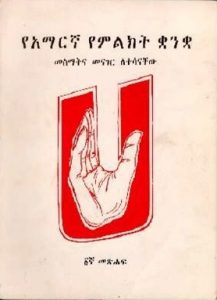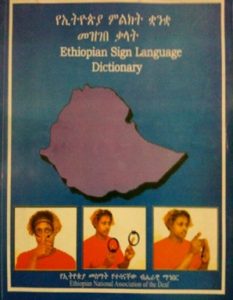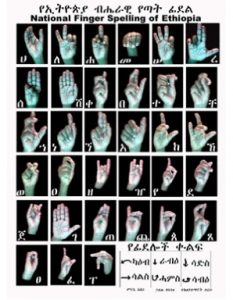Brief History of Ethiopian Sign Language (EthSL)
Pawlos Kassu (PHD)
There are few unwritten sources indicating the existence of Deaf community and Sign language in Ethiopia prior to the opening of schools for the Deaf. In the early 1960s, two schools for the Deaf were opened in Addis Ababa and Keren (Former state of Ethiopia in Eritrea) by missionaries from North America and Sweden. The Americans who opened schools in 1964 used to teach in the much-matured American Sign Language, while the Swedish who started in Keren used to teach in Sign language used by the Nordic countries, currently known as the “Swedish Sign Language”. Former students of the schools claimed that both languages were accepted equally though, there were a difference between them. The American Sign Language was mostly used in Central Ethiopia, while the Swedish in the Northern Parts of the country.
These students, who were the first to learn sign language at that time knowingly or unknowingly created their own in-house signs and introduced new local signs for words that do not have equivalent meaning in the American and Swedish Sign languages. Furthermore, they modified the signs in the two languages to have local meanings and used them to communicate local ideas and concepts. This has laid a foundation for the current Ethiopian Sign Language.
In late 1960s a new sign language with the above local influences began to emerge as a result of the interaction between students of the two schools due to work and other reasons. Ethiopian deaf students attending at the missionary schools and have developed their understanding of sign language through the Nordic and American sign Languages started shaping this initiative. The initiative was focused on creating fingerspelling equivalent of the geez alphabets, since the in-house sign languages and other initiatives mentioned above did not have their own fingerspelling. Some articles consider this period as the starting of EthSL (Yeheyes, 2003). However, it should be noted that this period was the introduction of fingerspelling rather than the Ethiopian Sign Language.
In 1972, a deaf person called Mr. Menase Abera attempted to create fingerspelling equivalent to geez alphabets for the first time. He shared his innovation to his deaf friend Mr. Tekelehaimanot Derso who was studying at the then Emperor Haileselasse University. The two friends made some improvements and brought it to Mr. Hailu Yesuneh the then deaf president of the National Association. Accordingly, Mr. Hailu formed a committee with three members to study the inventions. The committee members were Mr. Hailu himself, Mr.Menase and Mr. Tekelehaimanot. Mr. Menase’s focus was to spell the geez alphabets using the five fingers (for example፡- ሀ፣ ለ፣ ሐ፣ መ፣ ሠ፣ ረ፣ ቀ፣ በ፣ ተ፣ ቸ፣ ኀ፣ ነ፣ ወ፣ ዐ፣ ዘ፣ የ፣ ደ፣ ጀ፣ ጠ፣ ፈ፣ ጰ፣ ፐ). He also borrowed signs from the American Sign Language. (for example ረ፣ ነ፣ አ፣ ጸ). He was expected to create his own signs in situations where it is impossible use the two options mentioned above. (for example, ሸ፣ ኘ፣ ኸ፣ ዠ፣ ገ፣ ጨ፣ ፀ). In addition, Mr. Menase prepared alphabet keys or vowels (like ለካዕብ፣ ሣልስ፣ ራብዕ፣ ኀምስ፣ ሳድስ እና ሳብእ). Speaking about what the committee did Teklehaimanot said “There was a need to rotate 180˚ for basic sign of some keys. Therefore, I discussed with Mr. Menase and decided to represent them in the current shape. We have also made some changes on the geez sounds, previously prepared by Mr. Menase (Interview: Teklehaimanot, 2004).
The committee formed by Mr. Hailu submitted the results of the study to members of the Association and which obtained acceptance of the members. Then, it was sent to the Ministry of Education so that the Ministry considered using it in teaching deaf students. Consequently, the Ministry forwarded the fingerspellings to deaf schools for comments and inputs. The only comment made was from Abreha-Atsebeha on the letter “ወ”. The committee accepted the recommended change on the letter “ወ” not because there was a problem with the sign, but to create a sense of cooperation among parties. The fingerspelling were accepted by the schools and approved after incorporating.
Finally, it obtained acceptance and full support of the Ministry of Education. Therefore, the Ministry distributed circular letter to regions, so that it is used as a teaching material in schools where deaf students were studying. Mr. Teklehaimanot (2004) noted that Mr. Menase was not granted a copyright on the EthSL fingerspelling: “Mr. Menase was a humble and visionary individual. I have discussed the issue with him at that time. He said he is much concerned with how his innovation could help the deaf people rather than personal benefits. He told me that obtaining the Copyright doesn’t mean anything to him”.
The introduction of the fingerspelling solved the challenges of deaf students who were struggling to comprehend their culture and adequately communicate with the community, as they were studying in foreign sign languages. Furthermore, it served as a foundation for the preparation of the National Sign Language Dictionary.
The National Association of the Deaf proceeded with the preparation Sign Language Dictionary after obtaining approval on the fingerspelling from the Ministry of Education. However, it was mandatory to approach the Ministry of Education in order to make the deaf schools’ part of the preparation process. The responsibility of coordinating the matter was exclusively left for Mr. Hailu, since Mr. Menase and Mr. Teklehaimanot moved to Debreberhan and Assela, respectively following the National call to eradicate illiteracy (Teklehaimanot, 2004). In the year 1976, a meeting was held in a presence of representatives from two schools for the deaf (Mekanisa & Alpha), National Association of the Deaf, and Ministry of Education special education section and a decision was made to proceed with the preparation of Amharic Sign Language Dictionary after forming a committee comprised of the “four” parties.
Accordingly, a committee was formed encompassing nine individuals. Mr. Teklehaimanot Derso and Mr. Hailu Yesuneh were among the committee members. Mr. Teklehaimanot got the chance to be a committee member because he had returned to Addis Ababa, while Mr. Menase didn’t because he couldn’t return to Addis Ababa at that time. “The committee organized the draft by incorporating common signs used by the deaf, directly adapting the “international signs”, choosing major signs in our culture and borrowing compatible signs from the North American Sign Language” (ሀ Book, 1979).
The committee finalized and submitted the work to the Ministry of Education in 1976. “It should be noted that representatives of Ministry of Education didn’t contribute anything on the content of the book” (Teklehaimanot, 2004). The responsibility of editing the book was given to the Association. The Association was also tasked with the provision an illustrator and delivered as per the request by recruiting illustrators from its members. The committee passed decision so that the two schools pay for allowances of the two illustrators and Ministry of Education publish the educational book and all signs.

A book titled “Amharic Sign Language for the Deaf and Mute: “ሀ” Book”” was published in 1979, after three years of labor. This first sign language dictionary contained 15 chapters, Illustration of 1009 signs, and 270 non-illustrated sign descriptions. The dictionary was easy to understand, as it was presented with descriptions of phrases and illustrations, as well as lines and arrows indicating actions and directions. The aim of this was “to assist those who wish to help a deaf person, especially to empower parents in communicating with their children”.
Concerning the tittle one of the producers of the dictionary noted that,
- The main reason why we titled the dictionary “Amharic Sign Language” was that our knowledge of sign language was limited at that time. We were receiving teachings in North American and Swedish Sign Languages. However, English language was used when it comes to descriptions in the book form. Thus, we used to call them as English Sign Language. Many deaf students, Parents of deaf students, and other Ethiopians attracted to learn sign language were not able to use the book, since it was written in English. Therefore, our primary focus when preparing the dictionary was to solve this written language challenge, make the book accessible for all and contribute to the expansion of the sign language. We were not saying that the signs were Amharic. We were indicating that the descriptions in the dictionary are not in English like others, but in Amharic (Teklehaimanot, 2004)
The publication of this Sign Language Dictionary had highly contributed to the acknowledgement and expansion of the EthSL. The EthSL started to grow and expand after the publication of the dictionary. However, users started to ask for amendment of the dictionary by pointing shortcomings like; the direct adaptation of many signs from the American & Swedish sign languages, the title of the book ( stating the need to title the book “Ethiopia Sign Language” rather than “Amharic Sign Language, as well as the limited participation of deaf people in the preparation process. However, the amendment was not made until the year 2008, because the request was not supported by all and the National Association didn’t have the capacity to make the amendments without the support of the government.
The second attempt at producing an EthSL sign language dictionary was made by the government after 18 years in the early 1990s. The second dictionary titled “Sign Language Dictionary: Second Book” with 1314 signs was drafted in 1994 by the Special Needs Education Curriculum Development Team of the Vocational and Special Education Coordination Office and was published by Curriculum Development & Research Unit of the Ministry of Education in 1998 (It was computer typed and bonded manually). The dictionary didn’t receive much acceptance by the Deaf community, since it lacked the participation of the owners of the language & the Association.
In 2002, the Ethiopian National Association of the Deaf developed a Sign Language Development Project and submitted to the Finland Ministry of Foreign Affairs through Finnish National Association of the deaf. The Association was able to secure more than 85,000 Euros funding from the Ministry. The preparation of the dictionary started by the year 2002 and published in 2008, after six years.
This first dictionary published by the National Association of the Deaf (But, second in national terms and can be considered as third if the second dictionary is assumed) contained 464 pages covering 25 headings and 1322 signs. This dictionary was unique in its content and type compared to the first book or “ሀ” Book. First, it included National contents. It was titled “Ethiopian Sign Language” rather than “Amharic Sign Language” unlike its predecessor by Ministry of education. Second, the illustrations were presented by photographs rather than pictures and more than one photograph was used for a single sign as needed. Third, the words were written in Amharic & English so that those who are unable to read the Amharic can read the English. Fourth, it included action indicator arrows for signs borrowed from Finnish Sign Language. This made understanding much easier. Fifth, most of the signs were local. Sixth, its design & crafting was better. Seventh, it has involved linguists. This dictionary is the best compared to the others in all accounts and is the most disseminated one. What was known as the “Language of the dumbs” and later “Amharic Sign Language” gained its present name of “Ethiopian Sign Language” after the publication of this dictionary.
Among the major advents in the history of EthSL is the opening of the Ethiopian Sign Language & Deaf Culture Study Unit at Addis Ababa University in the year 2008. This undergraduate program is considered to be pioneer in Africa. The opening of this department has facilitated the modernization of EthSL education and facilitated the development of sign language interpreters. In addition, it has created suitable conditions for scientific studies and preservation of the language. More than hundred undergraduate and ten postgraduate researches have been carried out under this program unit; four of them at doctorate level.

These researchers acknowledged the presence unique grammar within the language, its difference from Amharic or other local languages, and its extensive use in all regions of the country as a tool to educate deaf students and communicate with deaf individuals. Researches under the department have continued. Furthermore, the department is making efforts to study and document al parts of EthSL.
Studies show that EthSL is being used widely in all regions with no major variation from place to place. Accordingly, users of the EthSL communicate in the language without any difficulty.

